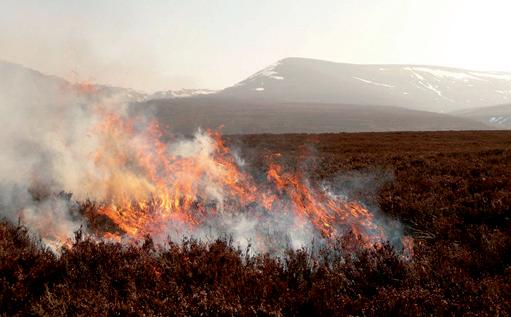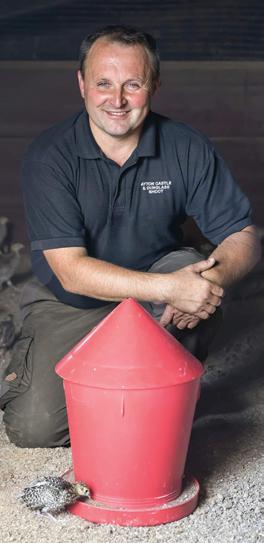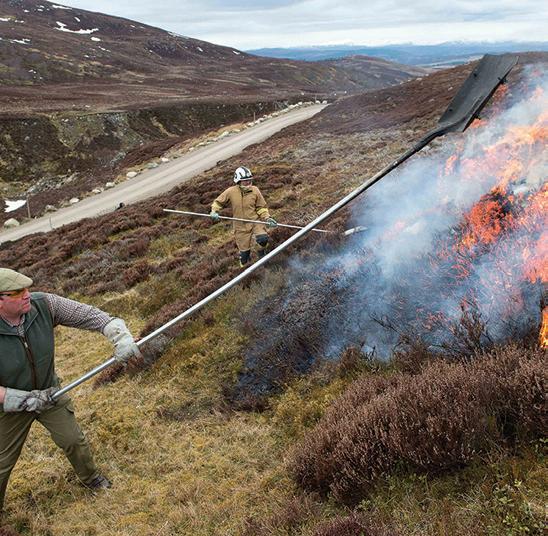
6 minute read
Conservation Matters
Successful first year for the Scottish Land Matching Service
The Scottish Land Matching Service (SLMS), supported by NFU Scotland, has had a successful frst year and is looking to build on its momentum.
Advertisement
Managed by Ian Davidson, former Head of Agriculture Policy at Scottish Government, the SLMS is a consortium approach, involving several Scottish stakeholders, which aims to match new entrants and developing businesses with wellestablished farmers and crofters who may be looking to step back.
In the past year, the service has received 152 enquiries with four times as many people looking for opportunities compared to those in a position to offer. Enquiries have included all scales and types of enterprise from market garden up to extensive sheep, cattle and arable operations. Four successful matches have been made, including a joint venture and partnership agreement, and this provides an excellent platform for a more successful matches in the future.
Ian Davidson said: “It has been a busy frst year for SLMS and tremendous strides have been made. I am really pleased with the number of enquiries and that SLMS has been able to help a number of parties reach successful agreements.
“There is a clear need and demand for this service. Its strength is that it provides free independent advice and facilitation for anybody thinking about a joint venture. This means that it can help parties interested in ventures of all scales and types”.
Trust (GWCT) Advisory Services in Scotland launches Muirburn Advisory Service
By Hugo Straker, GWCT Senior Advisor, Scotland
Muirburn, which covers the controlled burning of heather, gorse bushes and grasslands under the Hill Farming and other relevant Acts, is an important land management and conservation tool. With the muirburn season underway from 1 October, our new service provides an excellent opportunity for managers to review their muirburn practices. This is particularly important in light of the recent Scottish Government commissioned review of grouse moor management which made recommendations for increased regulation of muirburn activities.
The muirburn season was temporarily suspended earlier in the year due to the Coronavirus lockdown and the Scottish Government may once again impose

restrictions if the COVID-19 situation worsens. But at the time of writing it is business as normal.
The new Muirburn Advisory Service has been designed to help estates develop, maintain and deliver simple user-friendly muirburn plans in what is becoming an increasingly politically charged and sensitive environment. GWCT’s professional advisors will help estates and farms through specialist advice to evaluate and manage risk of harm to the environment from muirburn, and to undertake it in line with the revised Muirburn Code and meeting all necessary statutory requirements.
The new service provides three distinct options: moorland risk-mapping; muirburn planning; and muirburn mapping and monitoring.
Whilst GWCT has offered advice on muirburn in the past, it has not been formalised in the way that we can now present through the creation of a distinct and dedicated Muirburn Advisory Service.
In the current climate, with muirburn under increasing scrutiny every season, we believe that this service will provide invaluable support for safe, compliant muirburn planning and management, as well as assistance with Agrienvironment Climate Scheme (AECS) applications.
It builds on the training that we already offer and is an important step towards safeguarding this important conservation tool for the future.
For more information and prices contact the GWCT Muirburn Advisory Service via: Hugo Straker, Senior Advisor, Scotland 07713 074147 hstraker@gwct.org.uk or Nick Hesford, Advisor, Scotland 07896 006322 nhesford@gwct.org.uk See also https://www.gwct.org.uk/muirburn
Rural businesses boosted by shooting sector
The importance of the shooting sector to rural businesses has been underlined by new research from the University of Northampton which found that the direct economic beneft of grouse shooting is estimated to be £67.7million per annum for the UK as a whole.
In Scotland the grouse season is estimated to be worth £32m each year, directly supporting 2,640 jobs.
One business which benefts from shooting visitors is the Allanton Inn in Allanton, Berwickshire, an award-winning traditional pub and restaurant with rooms. Husband and wife team Katrina and William Reynolds have just celebrated ten years at the helm, with Katrina’s family farming in the local area for over 70 years.
Sporting visitors make up a signifcant part of their business in a normal year, some staying as guests and others dining in the restaurant. Katrina Reynolds said:
“Country sports are really important in Berwickshire - there are lots of sporting estates and the shooting season has a major impact on tourism.
“Many of the visitors are from the UK although we have an increasing number from Scandinavia, the Netherlands and Eastern Europe, especially Latvia. They love Scotland and its traditions. The shooting visitors extend the season into the Autumn and Winter so we have reliable revenue at a time when we wouldn’t normally be busy.”
In addition, a new business has been established, Andersen & Sondergaard Wild Game Charcuterie, selling charcuterie made from grouse, pheasant and venison. In 2019 their salami was awarded a Great Taste Award from the Guild of Fine Food.
Thor Sondergaard said: “I have developed the shooting business over the years and as well as taking on the fulltime keeper at Dunglass, I also offer 20 seasonal jobs every year for beaters and pickers-up. These seasonal workers include everyone from young people still studying and one man who is 90 years old and still enjoying the work.
“Obviously 2020 is not a good year for tourism but in normal times we have visitors coming in April and May for deer stalking and from October to February for pheasant shooting. It’s a 50-50 split between those coming from Europe and from the rest of the UK. They stay in the local hotels, holiday cottages and B & Bs and eat in the local Muirburn – the controlled, cool burning of heather on Scotland’s moorlands – is becoming ever more important in the fght against wildfres in Scotland, land managers are saying.
The latest science, published in May by Duke University in North Carolina, USA, has concluded high-intensity fres, such as wildfres, can destroy peat bogs and cause them to emit huge amounts of their stored carbon into the atmosphere whilst low-severity fres – such as muirburn - spark the opposite outcome.
Tim Baynes, Moorland Director at Scottish Land & Estates, said: “Muirburn – or heather burning – is a traditional land management practice backed by the latest science

restaurants, so it’s a major boost
Muirburn vital in aiding carbon storage and preventing wildfires

for the rural economy. and best practice. If muirburn is not carried out then we could gradually lose Scotland’s muchloved heather forever and that would be a tragedy for us and also the species which depend upon it. Grouse thrive in this habitat but so do other bird species – especially curlew, lapwing and golden plover which are low in numbers and are at real risk.
“Now, muirburn is also becoming an ever more important tool in combating wildfres. Scottish Fire & Rescue Service has supported controlled burning which involves lighting small strips of vegetation before they are quickly extinguished. This removes the top layer of old heather growth – reducing fuel load without damaging the land and mosses it sits upon.










